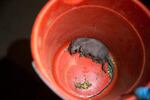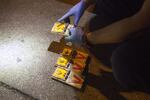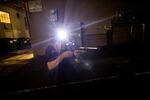
A Norway rat shot with a pellet gun in the alley behind University Book Store in Seattle. There are more rats in Seattle, and warmer climate means a longer breeding period -- and therefore more rats.
Mike Kane / KUOW
Seattle has a rat problem. Households here reported signs of rats at twice the national average, according to the 2013 American Housing survey. That’s meant good business for Adam Truitt, owner of Pest Fighter.
“It’s been absolutely crazy lately. Today I got 10 calls,” Truitt said as he and his trusty sidekick, a yorkiepoo named Olive, prepared to hunt rats.
So why all the rats?
Truitt suggested we meet in the alley behind the University Book Store to discuss.
When we meet, it’s 9:30 p.m. and dark out. Students laugh and call to one another on the street nearby. Food and trash spills from Dumpsters next to us. It reeks.
The main reason for all the rats? Us. More people living in cities means more trash and food waste.
“It’s like a buffet for the rodents. It’s all over town. All you gotta do is drive around at 9:30 at night and you’ll see rats running around everywhere,” Truitt says.
Over the past few weeks, Truitt has come here most nights with a pellet gun and shot close to 50 rats in this alley. When he does home visits to remove rats, he uses traps and poison. But he says with an infestation this bad, the pellet gun is the fastest and most humane way to deal with the problem. The King County Department of Health agrees.

Adam Truitt, 37, owner and founder of Pest Fighter, prepares traps to catch rats in an alley in Seattle's University District on Tuesday October 4, 2016.
Mike Kane / KUOW
Truitt says the rat problem has grown worse in the eight years he’s been on the job. That’s due partly to the rapidly growing human population in this city, but climate change is also a factor.
“The summers, they’ve been longer and the winters haven’t been as cold, have you noticed that?” Truitt says. “Not a lot of freezing going on in the winter time. So they’re just having more and more babies.”
A female rat can have up to 150 offspring each year. Gestation takes just 21 days and she can get pregnant a day after she gives birth.
When temperatures drop, rats stop breeding and focus on surviving. Many don’t make it through the winter, which keeps the overall population in check, says Jason Munshi-South, an expert on rat genetics and urban rodents at Fordham University in New York. Last year he was surprised to see rats burrowing and breeding in late December.
“We had a very mild winter for the most part,” Munshi-South says. “If it gets warmer over time, which seems to be happening in cities, which are already warmer, then when the spring rolls around you’re already going to have a lot of rats and they’re going to reproduce even more.”

Adam Truitt, 37, owner and founder of Pest Fighter, looks to exterminate rats with a pellet gun in an alley in Seattle's University District on Tuesday October 4, 2016.
Mike Kane / KUOW
New York City is perhaps the best place to study rats. Munshi-South traps Norway rats, the most common species of rat in U.S. cities, all over Manhattan.
“We’ve trapped a rat that was well over 600 grams, which is getting over 1lb. And it was quite a monster.”
But the Norway rat doesn’t actually come from Norway, or so the myth goes.
“It was a misnomer,” Munshi-South says laughing. “The story is that Carl Linnaeus, who was a very famous taxonomist, he was Swedish and he named the Norway rats to get in a dig at Norwegian. But some people dispute that version of the story.”
Unlike New York, Seattle has two kinds of resident rats. We’ve got the Norway rat – which tends to be bigger and stick to the ground. Those are the guys that burrow and hang out in sewers and subways.
But we also have the roof rat, or black rat. They tend to have bigger ears and longer tails, which help them balance better as they climb trees and vines.
These two species coexist here by divvying up habitat. The Norway rats stick to the ground burrows, tunnels, alleys and parking garages. The roof rats stick to the trees, vines and attics of the old single-family homes of the city. Both species love parks and green spaces.
“Definitely the more green space you have, soft soil available for burrowing, the more rats you can have,” Munshi-South said.

Adam Truitt, 37, owner and founder of Pest Fighter, pets his dog Olive before attempting to capture or kill rats in an alley in Seattle's University District on Tuesday October 4, 2016.
Mike Kane / KUOW
With tens of thousands of people moving to the Puget Sound region every year, construction in the city of Seattle has been booming.
Old houses or rundown, abandoned properties are popular rat hangouts or “reservoirs of rats” as Munshi-South calls them. When those buildings are torn down, there’s a rat exodus. Then they’ll try to colonize other homes in the neighborhood.
Listeners share their best (and worst) Seattle rat stories
“It can be difficult because it only takes one property on a neighborhood scale to be the source or reservoir of rats,” Munshi-South said.
Back in the alley in Seattle’s University District, there’s little movement. Truitt gets on his hands and knees with his pellet gun at the ready.
Suddenly, a large black Norway rat scurries out. Hearing a reporter’s squeal, the rat changes course and ducks into a hole in the concrete.
“Pop!” goes Truitt’s pellet gun. We can’t see into the hole but he believes the rat is dead. Truitt says it’s taken a few weeks to get this alley under control.
“When we first got here, they were everywhere. Every time I turned my head there was another one … and now it seems like there’s the same three or four running around.”
How well do you know rats? Take the KUOW/Local Wonder Quiz
He packs his pellet gun and returns to his truck where yorkiepoo Olive waits.
Truitt says the best way to keep rats out of your house is to seal up all the holes – even the little ones. A full grown rat can squeeze through a hole the size of a quarter. And to keep your compost covered and your trash tidy and out of reach of rodents.
Business for Truitt will most likely keep booming. Between climate change, construction, lots of green space and more people and trash – Seattle’s future looks ratty.
This story was inspired by a question from Susan Roxborough of Green Lake. Submit your local wonder about the Puget Sound region. If your question is chosen a KUOW reporter will investigate it.